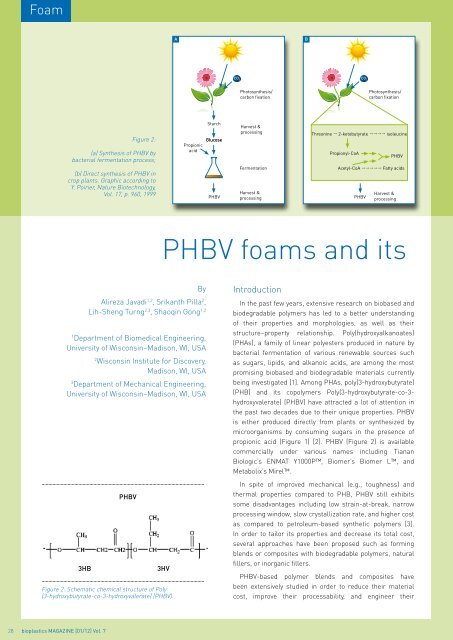bioplasticsMAGAZINE_1201
bioplasticsMAGAZINE_1201
bioplasticsMAGAZINE_1201
Create successful ePaper yourself
Turn your PDF publications into a flip-book with our unique Google optimized e-Paper software.
Foam<br />
A<br />
B<br />
CO 2<br />
CO 2<br />
Photosynthesis/<br />
carbon fixation<br />
Photosynthesis/<br />
carbon fixation<br />
Figure 2:<br />
(a) Synthesis of PHBV by<br />
bacterial fermentation process;<br />
(b) Direct synthesis of PHBV in<br />
crop plants. Graphic according to<br />
Y. Poirier, Nature Biotechnology,<br />
Vol. 17, p. 960, 1999<br />
Propionic<br />
acid<br />
Starch<br />
Glucose<br />
PHBV<br />
Harvest &<br />
processing<br />
Fermentation<br />
Harvest &<br />
processing<br />
Threonine 2-ketobutyrate isoleucine<br />
Propionyl-CoA<br />
Acetyl-CoA Fatty acids<br />
PHBV<br />
PHBV<br />
Harvest &<br />
processing<br />
PHBV foams and its<br />
By<br />
Alireza Javadi 1,2 , Srikanth Pilla 2 ,<br />
Lih-Sheng Turng 2,3 , Shaoqin Gong 1,2<br />
1<br />
Department of Biomedical Engineering,<br />
University of Wisconsin–Madison, WI, USA<br />
2<br />
Wisconsin Institute for Discovery,<br />
Madison, WI, USA<br />
3<br />
Department of Mechanical Engineering,<br />
University of Wisconsin–Madison, WI, USA<br />
3HB<br />
PHBV<br />
3HV<br />
Figure 2: Schematic chemical structure of Poly<br />
(3-hydroxybutyrate-co-3-hydroxyvalerate) (PHBV).<br />
Introduction<br />
In the past few years, extensive research on biobased and<br />
biodegradable polymers has led to a better understanding<br />
of their properties and morphologies, as well as their<br />
structure–property relationship. Poly(hydroxyalkanoates)<br />
(PHAs), a family of linear polyesters produced in nature by<br />
bacterial fermentation of various renewable sources such<br />
as sugars, lipids, and alkanoic acids, are among the most<br />
promising biobased and biodegradable materials currently<br />
being investigated [1]. Among PHAs, poly(3-hydroxybutyrate)<br />
(PHB) and its copolymers Poly(3-hydroxybutyrate-co-3-<br />
hydroxyvalerate) (PHBV) have attracted a lot of attention in<br />
the past two decades due to their unique properties. PHBV<br />
is either produced directly from plants or synthesized by<br />
microorganisms by consuming sugars in the presence of<br />
propionic acid (Figure 1) [2]. PHBV (Figure 2) is available<br />
commercially under various names including Tianan<br />
Biologic’s ENMAT Y1000P, Biomer’s Biomer L, and<br />
Metabolix’s Mirel.<br />
In spite of improved mechanical (e.g., toughness) and<br />
thermal properties compared to PHB, PHBV still exhibits<br />
some disadvantages including low strain-at-break, narrow<br />
processing window, slow crystallization rate, and higher cost<br />
as compared to petroleum-based synthetic polymers [3].<br />
In order to tailor its properties and decrease its total cost,<br />
several approaches have been proposed such as forming<br />
blends or composites with biodegradable polymers, natural<br />
fillers, or inorganic fillers.<br />
PHBV-based polymer blends and composites have<br />
been extensively studied in order to reduce their material<br />
cost, improve their processability, and engineer their<br />
28 bioplastics MAGAZINE [01/12] Vol. 7


















